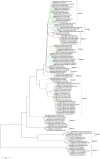First Data on the Occurrence and Genotyping of Enterocytozoon bieneusi in Wrestling Camels in Türkiye
- PMID: 40455338
- PMCID: PMC12129845
- DOI: 10.1007/s11686-025-01061-8
First Data on the Occurrence and Genotyping of Enterocytozoon bieneusi in Wrestling Camels in Türkiye
Abstract
Purpose: Enterocytozoon bieneusi is the most prevalent microsporidian parasite and has wide host diversity, including animals and humans. However, there are a limited number of studies on the presence, molecular epidemiology, and genotyping of E. bieneusi in camels worldwide. Currently, no data are available on the occurrence, distribution, and genotypes of E. bieneusi in wrestling camels in Türkiye. This study aimed to address the knowledge gap regarding E. bieneusi in wrestling camels in Türkiye.
Methods: In this study, a total of 110 fecal samples from camels in various provinces of Türkiye were investigated to reveal the presence of E. bieneusi, and the subsequent zoonotic potential of isolates was assessed at the genotype level by PCR-sequence analysis of the ribosomal internal transcribed spacer (ITS) gene region.
Results: Three fecal specimens were detected as E. bieneusi positive, and the overall prevalence was 2.72%. Further sequence analyses revealed a novel genotype hereby named camelEb from wrestling camels in the Aydin (n = 1) and Mugla (n = 2) provinces of Türkiye. In the phylogenetic analyses, the camelEb genotype clustered into group 6 with other genotypes reported from camels.
Conclusion: This is the first report on the presence of E. bieneusi in wrestling camels, suggesting that camels could also serve as a potential reservoir or carrier for E. bieneusi in Türkiye.
Keywords: Enterocytozoon bieneusi; Camels; Genotyping; ITS; Türkiye.
© 2025. The Author(s).
Conflict of interest statement
Declarations. Competing Interests: The authors declare no competing interests.
Figures


Similar articles
-
Genetic Diversity of Enterocytozoon bieneusi in Diarrheic Shelter Dogs in Romania: First Molecular and Phylogenetic Evidence.Pathogens. 2025 Jun 27;14(7):641. doi: 10.3390/pathogens14070641. Pathogens. 2025. PMID: 40732689 Free PMC article.
-
Genetic Characteristics of Enterocytozoon bieneusi in Cattle from Hebei Province, China.Acta Parasitol. 2025 Aug 7;70(4):168. doi: 10.1007/s11686-025-01114-y. Acta Parasitol. 2025. PMID: 40773072
-
High prevalence of Enterocytozoon bieneusi (microsporidia) in asymptomatic schoolchildren, Zambia.Med Mycol. 2025 Jul 2;63(7):myaf065. doi: 10.1093/mmy/myaf065. Med Mycol. 2025. PMID: 40693962
-
A systematic review and meta-analysis on the global prevalence of cattle microsporidiosis with focus on Enterocytozoon bieneusi: An emerging zoonotic pathogen.Prev Vet Med. 2022 Mar;200:105581. doi: 10.1016/j.prevetmed.2022.105581. Epub 2022 Jan 15. Prev Vet Med. 2022. PMID: 35066319
-
Global molecular epidemiology of microsporidia in pigs and wild boars with emphasis on Enterocytozoon bieneusi: A systematic review and meta-analysis.Vet Med Sci. 2022 May;8(3):1126-1136. doi: 10.1002/vms3.751. Epub 2022 Feb 3. Vet Med Sci. 2022. PMID: 35113502 Free PMC article.
References
-
- James TY, Pelin A, Bonen L et al (2013) Shared signatures of parasitism and phylogenomics unite Cryptomycota and microsporidia. Curr Biol 23(16):1548–1553. 10.1016/j.cub.2013.06.057 - PubMed
MeSH terms
Substances
LinkOut - more resources
Full Text Sources
Miscellaneous

